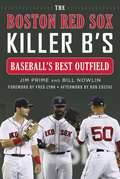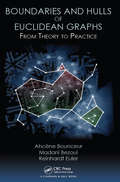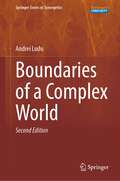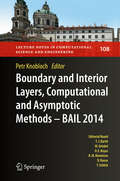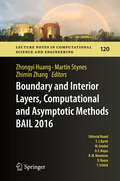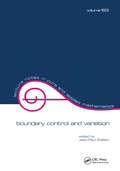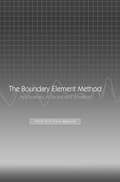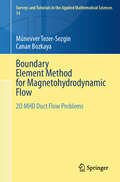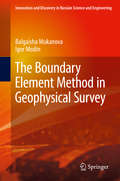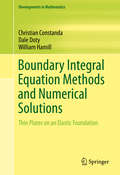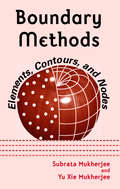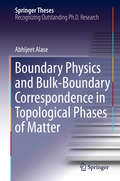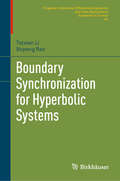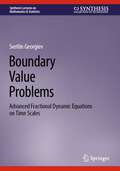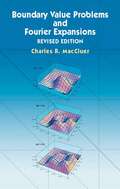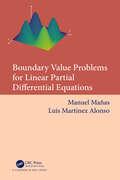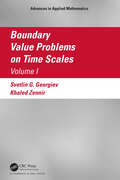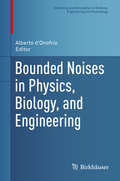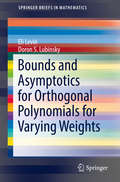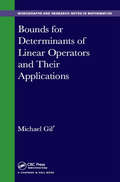- Table View
- List View
The Boston Red Sox Killer B's: Baseball's Best Outfield
by Jim Prime Bill NowlinLearn about the 2018 World Series-winning Red Sox outfield! Andrew Benintendi, Jackie Bradley Jr., and Mookie Betts, three superb outfielders who are known collectively as the "Killer B's," have set Major League Baseball abuzz. Most notably, they made up the Red Sox World Series-winning outfield in 2018, a season in which Betts was voted the American League MVP and received a Gold Glove, Bradley earned ALCS MVP accolades and also a Gold Glove, and Benintendi featured one of the smoothest swings since Ted Williams to complement his defensive prowess. In The Boston Red Sox Killer B's, veteran authors Jim Prime and Bill Nowlin team up once again to cover the young careers of all three players, with special emphasis on the 2018 season. Along the way, Prime and Nowlin incorporate on- and off-field stories and interviews with teammates to offer fans a better understanding of how this trio has transformed into New England folk heroes and how they have developed a chemistry unmatched by any other outfield around the league. This book serves as the perfect gift for any Red Sox fan!
Boundaries and Hulls of Euclidean Graphs: From Theory to Practice
by Ahcene Bounceur Madani Bezoui Reinhardt EulerBoundaries and Hulls of Euclidean Graphs: From Theory to Practice presents concepts and algorithms for finding convex, concave and polygon hulls of Euclidean graphs. It also includes some implementations, determining and comparing their complexities. Since the implementation is application-dependent, either centralized or distributed, some basic concepts of the centralized and distributed versions are reviewed. Theoreticians will find a presentation of different algorithms together with an evaluation of their complexity and their utilities, as well as their field of application. Practitioners will find some practical and real-world situations in which the presented algorithms can be used.
Boundaries of a Complex World (Springer Series in Synergetics)
by Andrei LuduThe centraltheme of this book is the extent to which the structure of the free dynamicalboundaries of a system controls the evolution of the system as a whole. Applyingthree orthogonal types of thinking - mathematical, constructivist andmorphological, it illustrates these concepts using applications to selectedproblems from the social and life sciences, as well as economics. In a broadercontext, it introduces and reviews some modern mathematical approaches to thescience of complex systems. Standard modeling approaches (based on non-lineardifferential equations, dynamic systems, graph theory, cellular automata,stochastic processes, or information theory) are suitable for studying localproblems. However they cannot simultaneously take into account all the differentfacets and phenomena of a complex system, and new approaches are required to solvethe challenging problem of correlations between phenomena at different levelsand hierarchies, their self-organization and memory-evolutive aspects, the growthof additional structures and are ultimately required to explain why and howsuch complex systems can display both robustness and flexibility. This graduate-leveltext also addresses a broader interdisciplinary audience, keeping themathematical level essentially uniform throughout the book, and involving onlybasic elements from calculus, algebra, geometry and systems theory.
Boundaries of a Complex World (Springer Series in Synergetics)
by Andrei LuduThe 2nd edition of this book provides novel topics and studyies in boundaries of networks and Big Data Systems.The central theme of this book is the extent to which the structure of the free dynamical boundaries of a system controls the evolution of the system as a whole. Applying three orthogonal types of thinking - mathematical, constructivist and morphological, it illustrates these concepts using applications to selected problems from the social and life sciences, as well as economics. In a broader context, it introduces and reviews some modern mathematical approaches to the science of complex systems. Standard modeling approaches (based on non-linear differential equations, dynamic systems, graph theory, cellular automata, stochastic processes, or information theory) are suitable for studying local problems. However they cannot simultaneously take into account all the different facets and phenomena of a complex system, and new approaches are required to solve the challenging problem of correlations between phenomena at different levels and hierarchies, their self-organization and memory-evolutive aspects, the growth of additional structures and are ultimately required to explain why and how such complex systems can display both robustness and flexibility. This graduate-level text addresses a broader interdisciplinary audience, keeping the mathematical level essentially uniform throughout the book, and involving only basic elements from calculus, algebra, geometry and systems theory.
Boundary and Interior Layers, Computational and Asymptotic Methods - BAIL 2014 (Lecture Notes in Computational Science and Engineering #108)
by Petr KnoblochThis volume offers contributions reflecting a selection of the lectures presented at the international conference BAIL 2014, which was held from 15th to 19th September 2014 at the Charles University in Prague, Czech Republic. These are devoted to the theoretical and/or numerical analysis of problems involving boundary and interior layers and methods for solving these problems numerically. The authors are both mathematicians (pure and applied) and engineers, and bring together a large number of interesting ideas. The wide variety of topics treated in the contributions provides an excellent overview of current research into the theory and numerical solution of problems involving boundary and interior layers.
Boundary and Interior Layers, Computational and Asymptotic Methods BAIL 2016 (Lecture Notes in Computational Science and Engineering #120)
by Zhongyi Huang Martin Stynes Zhimin ZhangThis volume collects papers associated with lectures that were presented at the BAIL 2016 conference, which was held from 14 to 19 August 2016 at Beijing Computational Science Research Center and Tsinghua University in Beijing, China. It showcases the variety and quality of current research into numerical and asymptotic methods for theoretical and practical problems whose solutions involve layer phenomena. The BAIL (Boundary And Interior Layers) conferences, held usually in even-numbered years, bring together mathematicians and engineers/physicists whose research involves layer phenomena, with the aim of promoting interaction between these often-separate disciplines. These layers appear as solutions of singularly perturbed differential equations of various types, and are common in physical problems, most notably in fluid dynamics. This book is of interest for current researchers from mathematics, engineering and physics whose work involves the accurate app roximation of solutions of singularly perturbed differential equations; that is, problems whose solutions exhibit boundary and/or interior layers.
Boundary and Interior Layers, Computational and Asymptotic Methods BAIL 2018 (Lecture Notes in Computational Science and Engineering #135)
by Gabriel R. Barrenechea John MackenzieThis volume gathers papers presented at the international conference BAIL, which was held at the University of Strathclyde, Scotland from the 14th to the 22nd of June 2018. The conference gathered specialists in the asymptotic and numerical analysis of problems which exhibit layers and interfaces. Covering a wide range of topics and sharing a wealth of insights, the papers in this volume provide an overview of the latest research into the theory and numerical approximation of problems involving boundary and interior layers.
Boundary Conformal Field Theory and the Worldsheet Approach to D-Branes
by Andreas Recknagel Aptara. IncBoundary conformal field theory is concerned with a class of two-dimensional quantum field theories which display a rich mathematical structure and have many applications ranging from string theory to condensed matter physics. In particular, the framework allows discussion of strings and branes directly at the quantum level. Written by internationally renowned experts, this comprehensive introduction to boundary conformal field theory reaches from theoretical foundations to recent developments, with an emphasis on the algebraic treatment of string backgrounds. Topics covered include basic concepts in conformal field theory with and without boundaries, the mathematical description of strings and D-branes, and the geometry of strongly curved spacetime. The book offers insights into string geometry that go beyond classical notions. Describing the theory from basic concepts, and providing numerous worked examples from conformal field theory and string theory, this reference is of interest to graduate students and researchers in physics and mathematics.
Boundary Control and Variation (Lecture Notes in Pure and Applied Mathematics)
by Jean-Paul ZolesioBased on the Working Conference on Boundary Control and Boundary Variation held in Sophia-Antipolis, France, this work provides important examinations of shape optimization and boundary control of hyperbolic systems, including free boundary problems and stabilization. It offers a new approach to large and nonlinear variation of the boundary using g
The Boundary Element Method: Applications in Sound and Vibration
by A. Ali C. RajakumarThe Boundary Element Method, or BEM, is a powerful numerical analysis tool with particular advantages over other analytical methods. With research in this area increasing rapidly and more uses for the method appearing, this timely book provides a full chronological review of all techniques that have been proposed so far, covering not only the funda
Boundary Element Method for Magnetohydrodynamic Flow: 2D MHD Duct Flow Problems (Surveys and Tutorials in the Applied Mathematical Sciences #14)
by Münevver Tezer-Sezgin Canan BozkayaBoundary Element Method for Magnetohydrodynamic Flow” offers one of the first systematic and detailed treatments of the application of boundary element method (BEM) to magnetohydrodynamic (MHD) flow problems. It aims to fill in the gaps left by the earlier books on the application of BEM to some physical problems such as fluid dynamics, elasticity, and geophysics. An overview of the theory of MHD flow and a comprehensive mathematical formulation of BEM for convection-diffusion-type differential equations are provided by the authors, who heavily rely on their research and experience in the disciplines of BEM and MHD flow. The book first discusses the basic principles of the BEM approach for the MHD duct flow problems in coupled form with the fundamental solution derived by the authors. Specifically, the BEM solutions of MHD flow in pipes of rectangular or circular cross-sections, and MHD flow in infinite regions, are all covered emphasizing the convergence of infinite boundary integrals. This book, especially, concentrates on the MHD flow in regions with partly insulated partly perfectly conducting boundaries by BEM giving also the parabolic boundary layer thickness emanating from the points of discontinuities on the walls. The book secondly includes the dual reciprocity boundary element technique (DRBEM), an alternative form of BEM that expands the applicability of BEM to MHD flow and heat transfer problems as well as buoyancy MHD flow with magnetic potential and inductionless MHD flow. The purpose of the book is to serve as a research book for applied mathematicians, engineers, scientists, and graduate students who wish to learn in-depth about the formulation and application of BEM in MHD flow problems. As such, it is an invaluable resource and a major contribution to the numerical solution of MHD flow problems.
The Boundary Element Method in Geophysical Survey
by Balgaisha Mukanova Igor ModinThis volume is devoted to the application of the integral equations method (IEM) and boundary elements method (BEM) to problems involving the sounding of geological media using direct current (DC). Adaptive mesh generation algorithms and numerical methods for solving a system of integral equations are discussed. Integral equations for the media, which contains piecewise linear contact boundaries, immersed local inclusions, and subsurface relief, are derived and solved numerically. Both 2.5D and 3D models with ground surface relief are considered. For 2D conductivity distributions, the influence of the relief on the interpretation of results is shown. Search solutions of the direct problem with ground surface relief are compared using the appropriate interpretation of results based on different inversion programs.
Boundary Integral Equation Methods and Numerical Solutions: Thin Plates on an Elastic Foundation (Developments in Mathematics #35)
by Christian Constanda Dale Doty William HamillThis book presents and explains a general, efficient, and elegant method for solving the Dirichlet, Neumann, and Robin boundary value problems for the extensional deformation of a thin plate on an elastic foundation. The solutions of these problems are obtained both analytically--by means of direct and indirect boundary integral equation methods (BIEMs)--and numerically, through the application of a boundary element technique. The text discusses the methodology for constructing a BIEM, deriving all the attending mathematical properties with full rigor. The model investigated in the book can serve as a template for the study of any linear elliptic two-dimensional problem with constant coefficients. The representation of the solution in terms of single-layer and double-layer potentials is pivotal in the development of a BIEM, which, in turn, forms the basis for the second part of the book, where approximate solutions are computed with a high degree of accuracy. The book is intended for graduate students and researchers in the fields of boundary integral equation methods, computational mechanics and, more generally, scientists working in the areas of applied mathematics and engineering. Given its detailed presentation of the material, the book can also be used as a text in a specialized graduate course on the applications of the boundary element method to the numerical computation of solutions in a wide variety of problems.
Boundary Methods: Elements, Contours, and Nodes (Mechanical Engineering)
by Subrata Mukherjee Yu Xie MukherjeeBoundary Methods: Elements, Contours, and Nodes presents the results of cutting-edge research in boundary-based mesh-free methods. These methods combine the dimensionality advantage of the boundary element method with the ease of discretization of mesh-free methods, both of which, for some problems, hold distinct advantages over the finite element
Boundary Physics and Bulk-Boundary Correspondence in Topological Phases of Matter (Springer Theses)
by Abhijeet AlaseThis thesis extends our understanding of systems of independent electrons by developing a generalization of Bloch’s Theorem which is applicable whenever translational symmetry is broken solely due to arbitrary boundary conditions. The thesis begins with a historical overview of topological condensed matter physics, placing the work in context, before introducing the generalized form of Bloch's Theorem. A cornerstone of electronic band structure and transport theory in crystalline matter, Bloch's Theorem is generalized via a reformulation of the diagonalization problem in terms of corner-modified block-Toeplitz matrices and, physically, by allowing the crystal momentum to take complex values. This formulation provides exact expressions for all the energy eigenvalues and eigenstates of the single-particle Hamiltonian. By precisely capturing the interplay between bulk and boundary properties, this affords an exact analysis of several prototypical models relevant to symmetry-protected topological phases of matter, including a characterization of zero-energy localized boundary excitations in both topological insulators and superconductors. Notably, in combination with suitable matrix factorization techniques, the generalized Bloch Hamiltonian is also shown to provide a natural starting point for a unified derivation of bulk-boundary correspondence for all symmetry classes in one dimension.
Boundary Synchronization for Hyperbolic Systems (Progress in Nonlinear Differential Equations and Their Applications #94)
by Tatsien Li Bopeng RaoWithin this carefully presented monograph, the authors extend the universal phenomenon of synchronization from finite-dimensional dynamical systems of ordinary differential equations (ODEs) to infinite-dimensional dynamical systems of partial differential equations (PDEs). By combining synchronization with controllability, they introduce the study of synchronization to the field of control and add new perspectives to the investigation of synchronization for systems of PDEs. With a focus on synchronization for a coupled system of wave equations, the text is divided into three parts corresponding to Dirichlet, Neumann, and coupled Robin boundary controls. Each part is then subdivided into chapters detailing exact boundary synchronization and approximate boundary synchronization, respectively. The core intention is to give artificial intervention to the evolution of state variables through appropriate boundary controls for realizing the synchronization in a finite time, creating a novel viewpoint into the investigation of synchronization for systems of partial differential equations, and revealing some essentially dissimilar characteristics from systems of ordinary differential equations. Primarily aimed at researchers and graduate students of applied mathematics and applied sciences, this text will particularly appeal to those interested in applied PDEs and control theory for distributed parameter systems.
Boundary Value Problems: Advanced Fractional Dynamic Equations on Time Scales (Synthesis Lectures on Mathematics & Statistics)
by Svetlin GeorgievThis book explores boundary value problems for fractional dynamic equations on arbitrary time scales, including Caputo fractional dynamic equations, impulsive Caputo fractional dynamic equations, and impulsive Riemann-Liouville fractional dynamic equations. The author provides an introduction to each fractional dynamic equation before delving into the problems. The book also covers initial value problems, boundary value problems, initial boundary value problems for each type of equation. The author provides integral representations of the solutions and proves the existence and uniqueness of the solutions.
Boundary Value Problems and Fourier Expansions
by Charles R. MaccluerBased on modern Sobolev methods, this text for advanced undergraduates and graduate students is highly physical in its orientation. It integrates numerical methods and symbolic manipulation into an elegant viewpoint that is consonant with implementation by digital computer. The first five sections form an informal introduction that develops students' physical and mathematical intuition. The following section introduces Hilbert space in its natural environment, and the next six sections pose and solve the standard problems. The final seven sections feature concise introductions to selected topics, including Sturm-Liouville problems, Fourier integrals, Galerkin's method, and Sobolev methods. 1994 edition. 64 figures. Exercises.
Boundary Value Problems for Linear Partial Differential Equations
by Manuel Mañas Luis Martínez AlonsoBoundary value problems play a significant role in modeling systems characterized by established conditions at their boundaries. On the other hand, initial value problems hold paramount importance in comprehending dynamic processes and foreseeing future behaviors. The fusion of these two types of problems yields profound insights into the intricacies of the conduct exhibited by many physical and mathematical systems regulated by linear partial differential equations.Boundary Value Problems for Linear Partial Differential Equations provides students with the opportunity to understand and exercise the benefits of this fusion, equipping them with realistic, practical tools to study solvable linear models of electromagnetism, fluid dynamics, geophysics, optics, thermodynamics and specifically, quantum mechanics. Emphasis is devoted to motivating the use of these methods by means of concrete examples taken from physical models. Features No prerequisites apart from knowledge of differential and integral calculus and ordinary differential equations. Provides students with practical tools and applications Contains numerous examples and exercises to help readers understand the concepts discussed in the book.
Boundary Value Problems on Time Scales, Volume I (Advances in Applied Mathematics)
by Svetlin G. Georgiev Khaled ZennirBoundary Value Problems on Time Scales, Volume I is devoted to the qualitative theory of boundary value problems on time scales. Summarizing the most recent contributions in this area, it addresses a wide audience of specialists such as mathematicians, physicists, engineers and biologists. It can be used as a textbook at the graduate level and as a reference book for several disciplines. The text contains two volumes, both published by Chapman & Hall/CRC Press. Volume I presents boundary value problems for first- and second-order dynamic equations on time scales. Volume II investigates boundary value problems for three, four, and higher-order dynamic equations on time scales. Many results to differential equations carry over easily to corresponding results for difference equations, while other results seem to be totally different in nature. Because of these reasons, the theory of dynamic equations is an active area of research. The time-scale calculus can be applied to any field in which dynamic processes are described by discrete or continuous time models. The calculus of time scales has various applications involving noncontinuous domains such as certain bug populations, phytoremediation of metals, wound healing, maximization problems in economics, and traffic problems. Boundary value problems on time scales have been extensively investigated in simulating processes and the phenomena subject to short-time perturbations during their evolution. The material in this book is presented in highly readable, mathematically solid format. Many practical problems are illustrated displaying a wide variety of solution techniques. AUTHORS Svetlin G. Georgiev is a mathematician who has worked in various areas of the study. He currently focuses on harmonic analysis, functional analysis, partial differential equations, ordinary differential equations, Clifford and quaternion analysis, integral equations, and dynamic calculus on time scales. Khaled Zennir earned his PhD in mathematics in 2013 from Sidi Bel Abbès University, Algeria. In 2015, he received his highest diploma in Habilitation in mathematics from Constantine University, Algeria. He is currently assistant professor at Qassim University in the Kingdom of Saudi Arabia. His research interests lie in the subjects of nonlinear hyperbolic partial differential equations: global existence, blowup, and long-time behavior.
Boundary Value Problems on Time Scales, Volume II (Advances in Applied Mathematics)
by Svetlin G. Georgiev Khaled ZennirBoundary Value Problems on Time Scales, Volume II is devoted to the qualitative theory of boundary value problems on time scales. Summarizing the most recent contributions in this area, it addresses a wide audience of specialists such as mathematicians, physicists, engineers and biologists. It can be used as a textbook at the graduate level and as a reference book for several disciplines. The text contains two volumes, both published by Chapman & Hall/CRC Press. Volume I presents boundary value problems for first- and second-order dynamic equations on time scales. Volume II investigates boundary value problems for three, four, and higher-order dynamic equations on time scales. Many results to differential equations carry over easily to corresponding results for difference equations, while other results seem to be totally different in nature. Because of these reasons, the theory of dynamic equations is an active area of research. The time-scale calculus can be applied to any field in which dynamic processes are described by discrete or continuous time models. The calculus of time scales has various applications involving noncontinuous domains such as certain bug populations, phytoremediation of metals, wound healing, maximization problems in economics, and traffic problems. Boundary value problems on time scales have been extensively investigated in simulating processes and the phenomena subject to short-time perturbations during their evolution. The material in this book is presented in highly readable, mathematically solid format. Many practical problems are illustrated displaying a wide variety of solution techniques. AUTHORS Svetlin G. Georgiev is a mathematician who has worked in various areas of the study. He currently focuses on harmonic analysis, functional analysis, partial differential equations, ordinary differential equations, Clifford and quaternion analysis, integral equations, and dynamic calculus on time scales. Khaled Zennir earned his PhD in mathematics in 2013 from Sidi Bel Abbès University, Algeria. In 2015, he received his highest diploma in Habilitation in mathematics from Constantine University, Algeria. He is currently assistant professor at Qassim University in the Kingdom of Saudi Arabia. His research interests lie in the subjects of nonlinear hyperbolic partial differential equations: global existence, blowup, and long-time behavior.
Bounded Gaps Between Primes: The Epic Breakthroughs of the Early Twenty-First Century
by Kevin BroughanSearching for small gaps between consecutive primes is one way to approach the twin primes conjecture, one of the most celebrated unsolved problems in number theory. This book documents the remarkable developments of recent decades, whereby an upper bound on the known gap length between infinite numbers of consecutive primes has been reduced to a tractable finite size. The text is both introductory and complete: the detailed way in which results are proved is fully set out and plenty of background material is included. The reader journeys from selected historical theorems to the latest best result, exploring the contributions of a vast array of mathematicians, including Bombieri, Goldston, Motohashi, Pintz, Yildirim, Zhang, Maynard, Tao and Polymath8. The book is supported by a linked and freely-available package of computer programs. The material is suitable for graduate students and of interest to any mathematician curious about recent breakthroughs in the field.
Bounded Noises in Physics, Biology, and Engineering (Modeling and Simulation in Science, Engineering and Technology)
by Alberto D'OnofrioSince the parameters in dynamical systems of biological interest are inherently positive and bounded, bounded noises are a natural way to model the realistic stochastic fluctuations of a biological system that are caused by its interaction with the external world. Bounded Noises in Physics, Biology, and Engineering is the first contributed volume devoted to the modeling of bounded noises in theoretical and applied statistical mechanics, quantitative biology, and mathematical physics. It gives an overview of the current state-of-the-art and is intended to stimulate further research. The volume is organized in four parts. The first part presents the main kinds of bounded noises and their applications in theoretical physics. The theory of bounded stochastic processes is intimately linked to its applications to mathematical and statistical physics, and it would be difficult and unnatural to separate the theory from its physical applications. The second is devoted to framing bounded noises in the theory of random dynamical systems and random bifurcations, while the third is devoted to applications of bounded stochastic processes in biology, one of the major areas of potential applications of this subject. The final part concerns the application of bounded stochastic processes in mechanical and structural engineering, the area where the renewed interest for non-Gaussian bounded noises started. Pure mathematicians working on stochastic calculus will find here a rich source of problems that are challenging from the point of view of contemporary nonlinear analysis. Bounded Noises in Physics, Biology, and Engineering is intended for scientists working on stochastic processes with an interest in both fundamental issues and applications. It will appeal to a broad range of applied mathematicians, mathematical biologists, physicists, engineers, and researchers in other fields interested in complexity theory. It is accessible to anyone with a working knowledge of stochastic modeling, from advanced undergraduates to senior researchers.
Bounds and Asymptotics for Orthogonal Polynomials for Varying Weights
by Eli Levin Doron S. LubinskyThis book establishes bounds and asymptotics under almost minimal conditions on the varying weights, and applies them to universality limits and entropy integrals. Orthogonal polynomials associated with varying weights play a key role in analyzing random matrices and other topics. This book will be of use to a wide community of mathematicians, physicists, and statisticians dealing with techniques of potential theory, orthogonal polynomials, approximation theory, as well as random matrices.
Bounds for Determinants of Linear Operators and their Applications (Chapman & Hall/CRC Monographs and Research Notes in Mathematics)
by Michael Gil'This book deals with the determinants of linear operators in Euclidean, Hilbert and Banach spaces. Determinants of operators give us an important tool for solving linear equations and invertibility conditions for linear operators, enable us to describe the spectra, to evaluate the multiplicities of eigenvalues, etc. We derive upper and lower bounds, and perturbation results for determinants, and discuss applications of our theoretical results to spectrum perturbations, matrix equations, two parameter eigenvalue problems, as well as to differential, difference and functional-differential equations.
